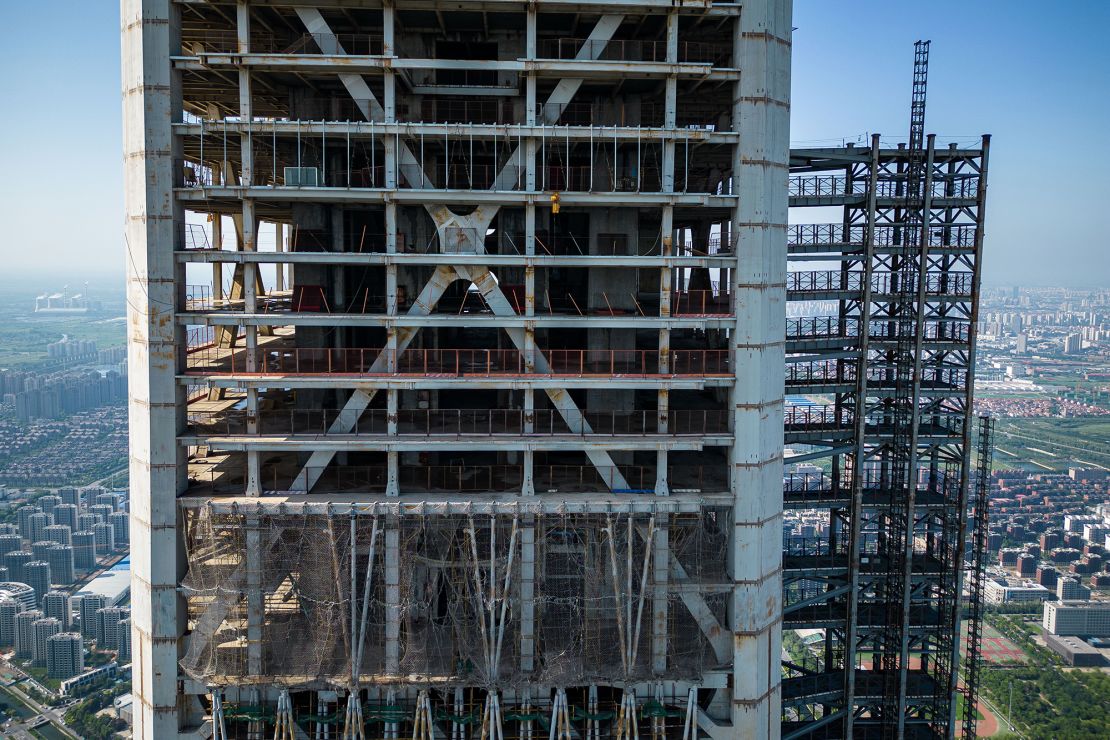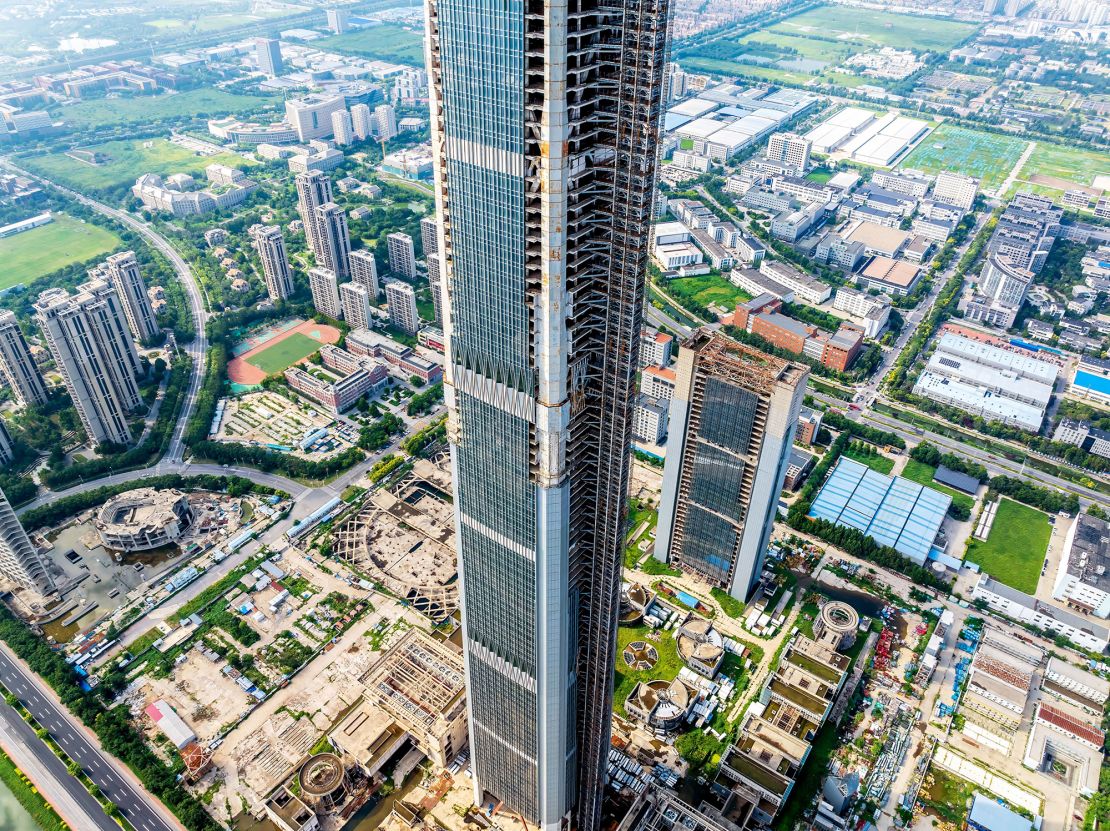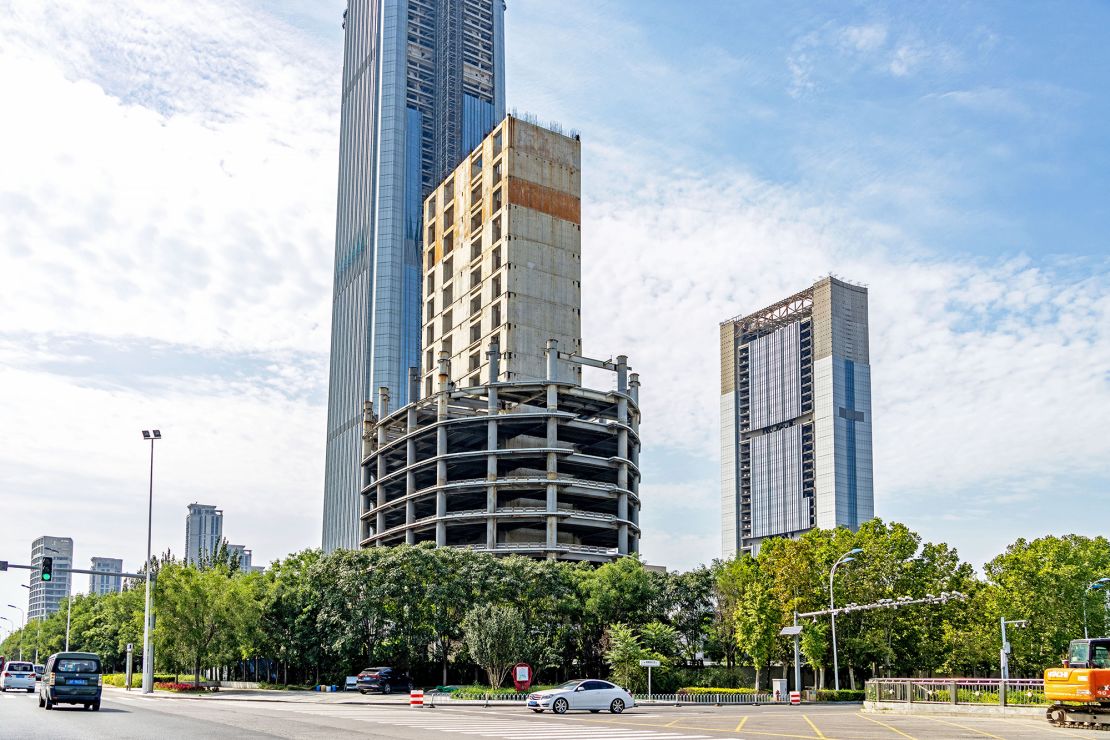CNN
—
Construction of the world’s tallest unoccupied skyscraper may resume as early as next week, almost 10 years after work ground to a halt, according to Chinese state media.
The 597-meter-tall (1,959-foot) Goldin Finance 117, which topped out in the northern Chinese port city of Tianjin but has stood unfinished since 2015 amid major financial difficulties, is now expected to complete in 2027.
At 117 stories high, the tower was set to be China’s tallest skyscraper when it broke ground in 2008. The soaring structure was built using “mega columns” to protect against strong winds and earthquakes, while its “walking stick” design was topped by a diamond-shaped atrium containing a swimming pool and observation deck. It was set to contain offices and a five-star hotel on the upper floors, according to architects P&T Group.
But the project came to a standstill following the 2015 Chinese stock market crash that plunged the future of Hong Kong-based Goldin Properties Holdings into doubt. The real estate developer, whose founder Pan Sutong was once among Hong Kong’s richest businessmen, has since gone into liquidation.

A new construction permit — which reportedly lists a contract value of almost 569 million yuan ($78 million) — suggests the defunct developer’s title may have been dropped from the building’s name, according to state media. It is unclear whether plans for the “supertall” skyscraper’s use remain unchanged. Neither P&T Group nor BGI Engineering Consultants, the state-owned company named on the permit, responded to CNN’s requests for comment.
Over the last decade, the abandoned skyscrapers littering China’s skylines have become emblematic of the country’s real estate woes. In 2020, its housing ministry and National Development and Reform Commission issued guidelines banning new towers over 500 meters (1,640 feet) in height — a move seemingly aimed, in part, at reining in the speculative financing often underpinning skyscraper projects.
On Monday, China’s Greenland Group announced that work is also resuming on the previously stalled Chengdu Greenland Tower in the southwestern city of Chengdu, local state-owned media reported. Construction of the 468-meter-tall (1,535-foot) skyscraper has been on hold since 2023, after the state-owned developer encountered financial difficulties, according to Reuters.
The fact that two high-profile projects are resuming at the same time is unlikely to be a coincidence, said Qiao Shitong, a law professor at Duke University School of Law and the author of two books on Chinese real estate.
“The national government has made it clear it wants to stabilize the real estate market,” said Qiao over a video call, adding that it has been encouraging local governments to help “revive” the struggling sector. “It is signaling to the market — (it’s) not only about the skyscrapers themselves.”

Although the Tianjin tower’s new financing is yet to be disclosed, Qiao believes the state has offered investment and debt restructuring to help kickstart the project.
“(Supertall skyscrapers) are not necessarily the most efficient projects and they are not necessarily making profits, but they are indicators,” he said. “By having this project revived and completed, the government at least hopes it can increase people’s confidence.”
For local officials, completing abandoned skyscrapers is also about “the image of the city,” said Fei Chen, a reader in architecture and urban design at the UK’s University of Liverpool. “They don’t want a project to be unfinished and to stay like that, which is an eyesore for everyone.”
Chen stressed, however, that the resumption of projects in Tianjin and Chengdu is unlikely to herald a return to the “vanity projects” of recent years.
“The government is conscious that although these (skyscraper) projects have some positive effects on the area, they require too much investment and are not financially or environmentally sustainable… I think the general urban development trend is not changed by the fact that some projects are being resumed. I think it’s more about local government efforts to make their city better.”

Despite economic concerns and tightening regulations, China continues to dominate global skyscraper construction. Of the 133 skyscrapers measuring 200 meters or above completed around the world last year, 91 were in China, according to data from the Council on Tall Buildings and Urban Habitat.
Chen said that skyscrapers, although expensive to build, are often used by developers as “magnets” for investment in the surrounding area. Goldin Finance 117, for instance, was part of a wider development containing villas, commercial buildings and offices, as well as a convention center, entertainment center and polo club. The fate of these projects is not explicitly outlined in the new construction permit, though it reportedly describes the development of several “commercial corridors.”
But with sluggish property sales and struggling office occupancy rates across China, the project’s economic viability remains in question, said Qiao. “It’s a huge investment,” he added “And I seriously don’t know who is going to buy or rent this commercial space.”
During the decade-long hiatus, Tianjin welcomed another supertall skyscraper — the Tianjin CTF Finance Centre, which at 530 meters (1,739 feet) is currently the world’s eighth tallest completed building. Goldin Finance 117 has meanwhile been surpassed in height by both the twisting Shanghai Tower and the Ping An Finance Centre in Shenzhen, meaning it would now only become the country’s third tallest (and the world’s sixth tallest) skyscraper upon completion.
It will fall to eighth globally if Saudi Arabia’s kilometer-high Jeddah Tower — on which construction also recently resumed, following a years-long hiatus — and Dubai’s Burj Azizi are both completed later this decade.
CNN’s Fred He and Hassan Tayir contributed to this report.

